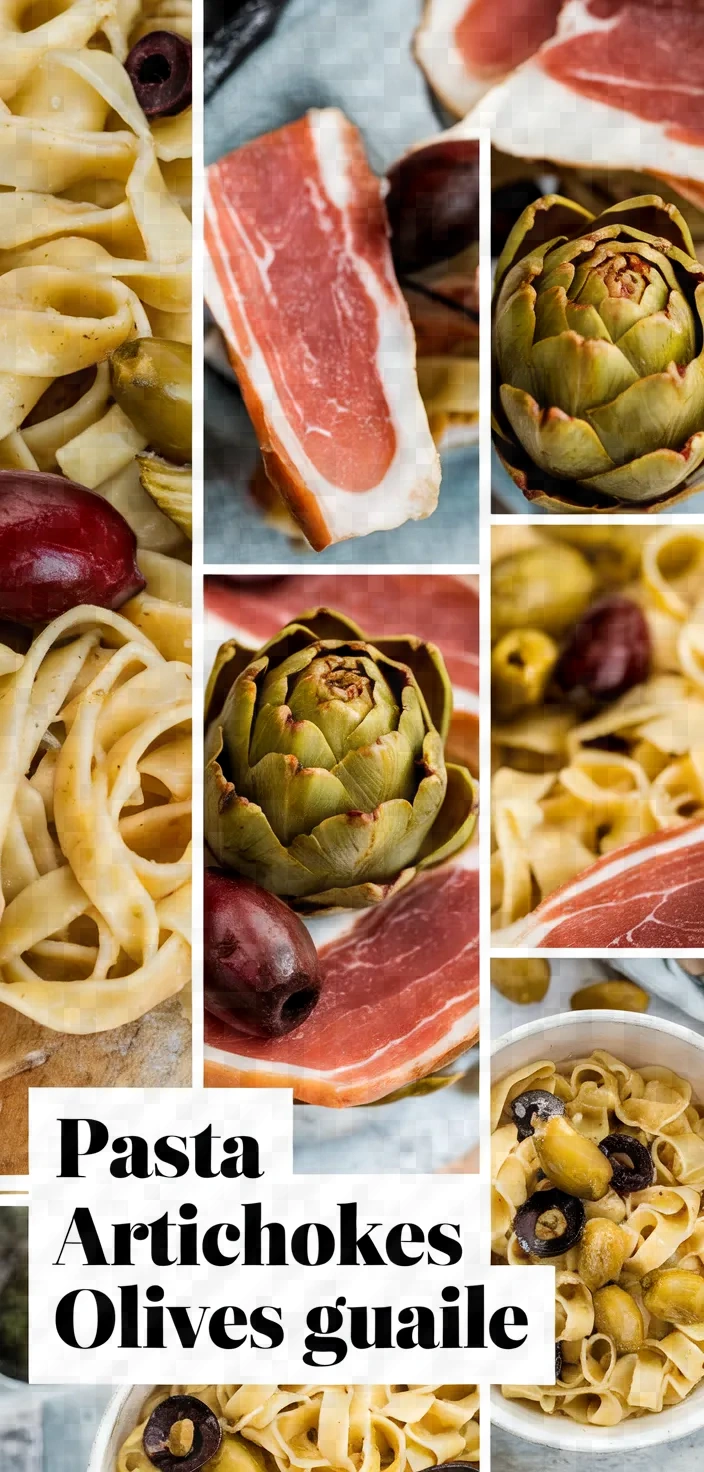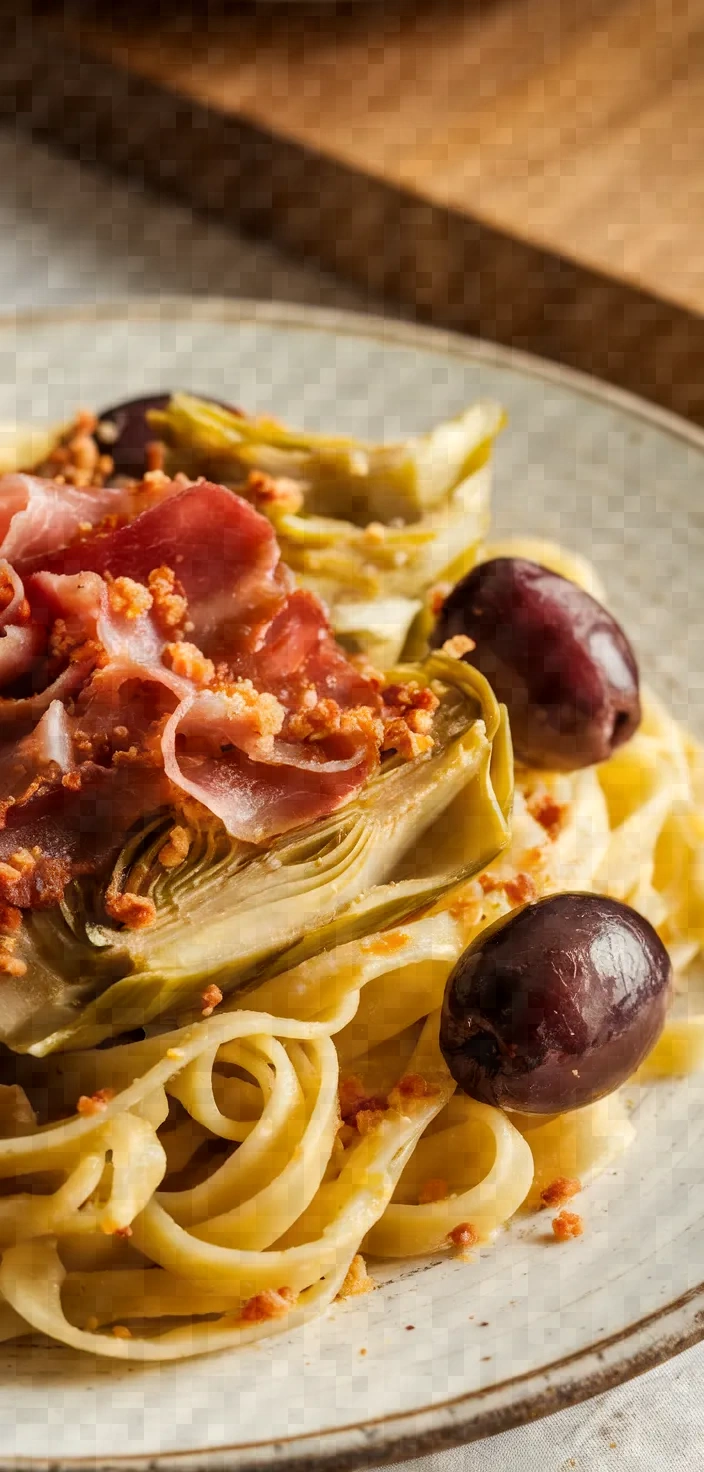If you’re anything like me, the idea of transforming fresh artichokes and savory guanciale into a mouthwatering pasta dish gets your culinary curiosity buzzing—time to dive into this delicious adventure! 🍝✨

My passion lies in creating meals that are not only flavorful but also simple. Case in point: my Pasta With Fresh Artichokes, Olives, and Guanciale.
Here, the rich, savory essence of crispy guanciale (an unsmoked Italian cured meat, made from pork cheek or jowl) complements the delicate freshness of artichokes (see The Veggie Life), which are enhanced by a hint of lemon juice. The olives and Pecorino Romano (or any aged sheep’s milk cheese) add the perfect touch of umami.
Ingredients

- Fresh Artichokes: Rich in fiber, artichokes aid digestion and add a savory depth.
- Guanciale: Cured pork jowl, delivers rich umami and crisp texture.
- Olive Oil: Heart-healthy fat, enhances flavors and adds smoothness.
- Green Olives: Salty, briny bites that balance and complement flavors.
- Pecorino Romano Cheese: Sharp, tangy cheese that adds savory richness.
- Red Pepper Flakes: Imparts a subtle heat, enhancing the dish’s complexity.
Ingredient Quantities
- 4 fresh artichokes
- 1 tablespoon lemon juice
- 3 tablespoons olive oil
- 100 grams guanciale, cubed
- 2 cloves garlic, thinly sliced
- 1/2 cup green olives, pitted and halved
- 1/2 teaspoon red pepper flakes
- 350 grams pasta of choice (e.g., spaghetti or penne)
- Salt, to taste
- Freshly ground black pepper, to taste
- 1/4 cup grated Pecorino Romano cheese
- 2 tablespoons chopped fresh parsley, for garnish
How to Make this
1. Start by getting the artichokes ready. Reduce them to their basic form by removing the leaves that are not fit for consumption. Cut off the top third of the artichoke that is mostly leaf. Trim the stems and don’t forget to remove any tough outer peel. Slice the artichokes into quarters and use a spoon to scoop out the fuzzy part that close to the center. Rinse them in a bowl of water with lemon juice to keep them from browning.
2. In a big frying pan or skillet, warm the olive oil over medium heat. Stir in the guanciale and sauté it until it begins to reach that crispy texture we want, which takes about 5 minutes. This is the base of our sauce!
3. Into the pan, add the sliced garlic and cook for 1 minute until fragrant.
4. Remove the artichokes from the can and add them to the skillet. Sauté for about 8–10 minutes, or until they become tender.
5. Combine the olives and red pepper flakes, cooking them for an additional 2–3 minutes.
6. At the same time, bring a big pot of salted water to a rolling boil. Add the pasta and cook according to the directions on the package until it is just a bit firmer than you want it to be (“al dente,” which means “to the tooth” in Italian, has come to signify a certain way of cooking pasta).
7. Combine the drained pasta with the artichoke mixture in the skillet. Add reserved pasta water as necessary and light sauce to create a tossable dish.
8. Add salt and freshly ground black pepper to taste to the mixture.
9. Disperse the grated Pecorino Romano cheese over the pasta and mix until well integrated and creamy.
10. Serve the pasta steaming hot, topped with freshly chopped parsley. Enjoy your tasty ensemble with fresh artichokes, olives, and guanciale!
Equipment Needed
1. Cutting board
2. Chef’s knife
3. Vegetable peeler
4. Spoon
5. Large bowl
6. Frying pan or skillet
7. Wooden spoon or spatula
8. Large pot
9. Colander
10. Cheese grater
11. Measuring cups and spoons
FAQ
- Q: Can I use canned artichokes instead of fresh ones?A: Giving a distinctive flavor and texture to any dish, fresh artichokes are a chef’s delight, but when time constraints are tight, opt for artichokes that come in a can. Just be sure to drain them well and give them a good pat-down to get rid of excess moisture before using.
- Q: What can I use instead of guanciale?Pancetta or thick-cut bacon can be used instead of guanciale, but they might add a slightly different taste to the dish.
- Q: Which type of pasta works best with this recipe?A: You can use whatever type of pasta you prefer, but both spaghetti and penne work nicely. For better sauce adherence, consider ridge-y pasta.
- Q: Is there a vegetarian version of this recipe?A: You can leave out the guanciale and use smoked paprika or vegan bacon alternatives to achieve a smoky flavor.
- Q: How can I prevent artichokes from browning?A: After trimming, soak the artichokes in water with a tablespoon of lemon juice so that they do not brown. The soaking helps leach the inulin from the artichokes, thus making them taste sweeter.
- Q: Can this dish be made ahead of time?A: You can serve it fresh, but you can also prepare it ahead of time and combine the elements right before serving. If you make it in advance and reheat it, add a splash of water or broth to loosen it up if necessary.
- Q: Can I make this recipe gluten-free?Yes, just use gluten-free pasta. Make sure the rest of the ingredients are certified gluten-free if necessary.
Pasta With Fresh Artichokes Olives Guanciale Recipe Substitutions and Variations
Artichokes:
Canned or marinated artichoke hearts can be used as a substitute for fresh artichokes.
Guanciale:
Bacon or pancetta may be used in place of guanciale, if necessary.
Green olives:
You can use black olives or even Kalamata olives for a different flavor.
Pecorino Romano cheese:
Grana Padano or Parmesan cheese are suitable substitutes.
Fresh parsley:
As a garnish, fresh basil, cilantro, or chives can be used instead.
Pro Tips
1. Prepping Artichokes: When preparing the artichokes, have a bowl of acidulated water (water with lemon juice) ready to prevent browning. Consider wearing gloves to avoid staining your hands with artichoke juice.
2. Crisping Guanciale: For extra crispy guanciale, start by adding it to a cold pan and then heat it gradually. This helps render out more fat, enhancing flavor and texture.
3. Pasta Water Magic: Save a cup of pasta water before draining. Its starchiness helps thicken the sauce and adhere it to the pasta, giving a luscious finish.
4. Enhanced Flavor: Consider adding a splash of white wine to deglaze the pan after cooking the garlic. This adds depth and a subtle acidity to balance the dish.
5. Cheese and Pepper: Mix freshly grated Pecorino Romano with a bit of freshly cracked black pepper before adding to the pasta for an extra burst of flavor that complements the cheese’s saltiness.

Pasta With Fresh Artichokes Olives Guanciale Recipe
My favorite Pasta With Fresh Artichokes Olives Guanciale Recipe
Equipment Needed:
1. Cutting board
2. Chef’s knife
3. Vegetable peeler
4. Spoon
5. Large bowl
6. Frying pan or skillet
7. Wooden spoon or spatula
8. Large pot
9. Colander
10. Cheese grater
11. Measuring cups and spoons
Ingredients:
- 4 fresh artichokes
- 1 tablespoon lemon juice
- 3 tablespoons olive oil
- 100 grams guanciale, cubed
- 2 cloves garlic, thinly sliced
- 1/2 cup green olives, pitted and halved
- 1/2 teaspoon red pepper flakes
- 350 grams pasta of choice (e.g., spaghetti or penne)
- Salt, to taste
- Freshly ground black pepper, to taste
- 1/4 cup grated Pecorino Romano cheese
- 2 tablespoons chopped fresh parsley, for garnish
Instructions:
1. Start by getting the artichokes ready. Reduce them to their basic form by removing the leaves that are not fit for consumption. Cut off the top third of the artichoke that is mostly leaf. Trim the stems and don’t forget to remove any tough outer peel. Slice the artichokes into quarters and use a spoon to scoop out the fuzzy part that close to the center. Rinse them in a bowl of water with lemon juice to keep them from browning.
2. In a big frying pan or skillet, warm the olive oil over medium heat. Stir in the guanciale and sauté it until it begins to reach that crispy texture we want, which takes about 5 minutes. This is the base of our sauce!
3. Into the pan, add the sliced garlic and cook for 1 minute until fragrant.
4. Remove the artichokes from the can and add them to the skillet. Sauté for about 8–10 minutes, or until they become tender.
5. Combine the olives and red pepper flakes, cooking them for an additional 2–3 minutes.
6. At the same time, bring a big pot of salted water to a rolling boil. Add the pasta and cook according to the directions on the package until it is just a bit firmer than you want it to be (“al dente,” which means “to the tooth” in Italian, has come to signify a certain way of cooking pasta).
7. Combine the drained pasta with the artichoke mixture in the skillet. Add reserved pasta water as necessary and light sauce to create a tossable dish.
8. Add salt and freshly ground black pepper to taste to the mixture.
9. Disperse the grated Pecorino Romano cheese over the pasta and mix until well integrated and creamy.
10. Serve the pasta steaming hot, topped with freshly chopped parsley. Enjoy your tasty ensemble with fresh artichokes, olives, and guanciale!







